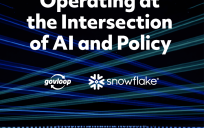The White House recently released the Executive Order on the Safe, Secure, and Trustworthy Development and Use of Artificial Intelligence to, among other things, provide guidance for federal agencies on the use of artificial intelligence (AI) tools and technologies. Included in this guidance is a provision that strongly discourages agencies from “imposing broad general bans or blocks on agency use of generative AI.”

This provision is notable because it seems to be at odds with recent actions taken by some agencies to restrict the use of generative AI by their employees and contractors. Why was this guidance against imposing general bans against the use of generative AI included in the recent Executive Order, and why is it important? To understand this, it helps to think about other paradigm-changing technologies that have developed in the past and how blanket bans on their use have impacted agency behavior and adoption of those technologies.
On the Hunt for Shadow IT
In the spring of 2004 I was riding around Dover, Delaware in a Mustang convertible. My driver was a coworker at the state’s technology department named Jamie, a member of the network security team, and a muscle car aficionado. Jamie was charged that early spring evening with driving to the locations of various state offices around the capital city and scanning for wi-fi networks. I decided to join him on one of his runs to learn more about it.
At the time, wi-fi was a disruptive new tool that was changing the way that people used technology — including government agencies. The increasing ubiquity of personal digital assistants, laptops and other mobile devices, and the ready availability of new wireless routers boasting support for the very latest wireless standards, was driving the adoption of wi-fi. For Jamie, these nightly runs around town with a wi-fi detector were pretty frequent. The official policy of the state at the time was that wi-fi routers were not sanctioned for use in government offices because of the ease with which a misconfiguration could expose the state network to potential attack. This new technology presented a potentially great risk, so it was banned. Period.
Every wi-fi router we were able to identify was therefore unsanctioned, and the state offices found to be using them were immediately asked to disconnect them. I remember asking Jamie how often he detected unsanctioned wi-fi routers on these nightly rides. “Every time. Sometimes multiple times on the same run,” he told me. Clearly the outright ban on wi-fi wasn’t working.
Jamie eventually stopped driving around town in his Mustang. And the state’s IT department eventually issued guidance to agencies on how to properly buy, install, and configure wi-fi routers in state offices. And I learned an invaluable lesson about how IT policies — particularly ones that ban specific kinds of technologies or tools outright — can impact behavior.
Why Bans Won’t Work
Almost 20 years after that drive, the disruptive new technology is generative AI. And broad, general bans against its use are likely to be as effective as the bans against agencies implementing their own wi-fi networks in the early 2000’s.
When new technologies become available that are powerful, accessible, and meet real challenges facing government agencies, there are strong incentives for agencies to adopt them. Simply banning these technologies outright doesn’t work. Faced with increasing pressure to deliver improved outcomes with stagnant or decreasing resources, agencies need to look to every possible tool or solution to help them meet their goals. Blanket technology bans often don’t provide agencies with the ability to test out or experiment with these new tools to see how they might meet their needs. When it comes to tools like generative AI, agencies need room to experiment and find out how to best use them.
Blanket technology bans spawn shadow IT, and incentivize agencies to hide their use of new technology for fear of having it taken away. The better solution to balancing security and other imperatives with the adoption of new technologies is to provide secure pathways for agencies to obtain and use them. Showing agencies the proper way to use these tools through detailed guidance, documentation, reference implementations, and ongoing training is a much better way to govern the adoption of tools like generative AI.
By discouraging the use of blanket bans against generative AI, the recently released Executive Order provides the foundation for a much more effective way for agencies to embrace this new technology.
Mark Headd is a Government Technology SME at Ad Hoc. He is the former Chief Data Officer for Philadelphia, serving as one of the first municipal chief data officers in the United States. He holds a Master’s Degree in Public Administration from the Maxwell School at Syracuse University, and is a former adjunct instructor at the University of Delaware’s Institute for Public Administration. He spent 6 years with the General Service Administration’s Technology Transformation Services (TTS), serving on the leadership team for 18F and leading customer success efforts for TTS’ cloud platform, which supports over 30 critical federal agency systems.





Leave a Reply
You must be logged in to post a comment.